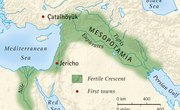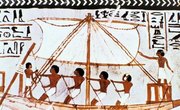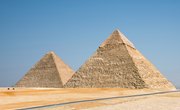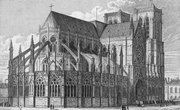Sumerians developed many things that remain part of modern life such as writing, timekeeping, irrigation and cities. They settled around 3500 B.C. in southern Mesopotamia, a region that covers the lower reaches of the Tigris and Euphrates rivers in today’s Iraq. The Sumerians are believed to have migrated to the northern shores of the Persian Gulf from Central Asia and India.
Pictographs and Writing
The invention of writing is attributed to the Sumerians around 3200 B.C. At first, objects were represented as simple pictures, also called pictograms or pictographs, pressed into soft clay tablets. The Sumerians used pictographs for commercial record keeping rather than conveying sounds, according to the University of Chicago Oriental Institute. The pictures gradually were reduced to a series of wedge-shaped signs – cuneiform – because of the difficulty of drawing curves and lines in clay. By 3000 B.C., Sumerians had developed a system of phonetic writing. Each sign denoted a sound that could be used to write a word. Hittites, Babylonians, Persians and Assyrians later copied the cuneiform script. The cuneiform texts recorded messages and historical events as well as commercial transactions. They evolved into producing written sagas such the Epic of Gilgamesh, the world’s oldest surviving literary work.
Sexagesimal System
Sumerians developed a system of numbers with a base of 60, today called the sexagesimal system. They began by creating symbols and signs for numbers and eventually identified 60 such numerical representations. Over the years, they reduced the number of symbols to just two, combinations of which could be used to represent any number. This system was the foundation of timekeeping and geometry. An hour of time was divided into 60 minutes while a circle was divided into 360 degrees. The 12-inch foot, the three-foot yard and the concept of a “dozen" are legacies of the Sumerian numerical system.
Irrigation and Flood Control
The Sumerians depended on the Tigris and Euphrates rivers to water their crops. However, there was little rainfall in southern Mesopotamia, as in Iraq today. In spring and early summer, snowmelt from the northern mountains caused massive flooding in the lower reaches of the rivers, destroying both crops and settlements. River channels changed courses. Sumerians created sophisticated water transport systems that would both irrigate crops during dry periods and control flooding during the spring. This water management enabled them to build up a food surplus for trading. They exchanged barley and wheat for stone and lumber.
City States
Sumerians developed their settlements into over 20 city states, the world’s first urban centers, such as Ur, Adab, Nippur and Eridu. Each city state was an independent political unit and often warred with other city states over water rights and territory. These cities were centers of administration, religion, commerce, manufacturing and entertainment. The Sumerians created a distinct social structure. Each city was headed by a priest king and social elite of nobles, who ruled over commoners and slaves, and had a patron god or goddess. However, there were only a few major deities such as Anu the father of the gods and sky god, Utu was the sun god and Enlil who was the god of the air. The priest king was not a god but the representative of deity on Earth.
Monumental Architecture
Sumerians used mud bricks that baked and hardened in the sun as their main building material. They developed a monumental style of architecture for city walls, public buildings and temples and invented the column, the arch and even had knowledge of constructing a dome. The city’s most important public buildings were congregated around a central temple that was the center of power. Artisan and private dwellings were packed around winding, narrow streets. The temple itself was dominated by a tower and stairway called a ziggurat that resembled a stepped pyramid with a flat top. Ziggurats were the home of deities and not used for public worship. This took place in neighboring temples.
Related Articles
References
Resources
Writer Bio
Based in London, Maria Kielmas worked in earthquake engineering and international petroleum exploration before entering journalism in 1986. She has written for the "Financial Times," "Barron's," "Christian Science Monitor," and "Rheinischer Merkur" as well as specialist publications on the energy and financial industries and the European, Middle Eastern, African, Asian and Latin American regions. She has a Bachelor of Science in physics and geology from Manchester University and a Master of Science in marine geotechnics from the University of Wales School of Ocean Sciences.











